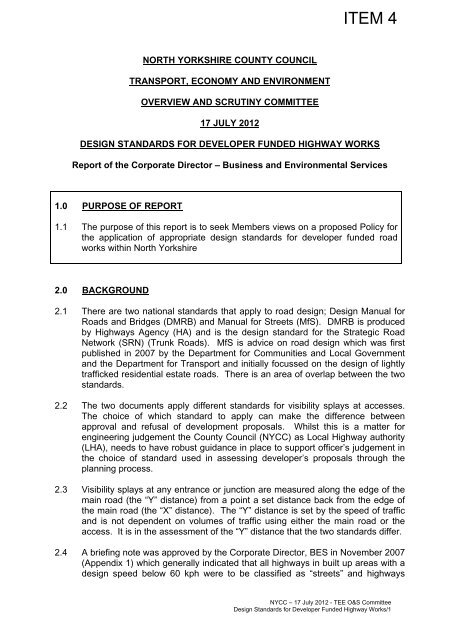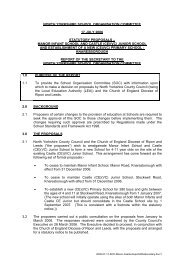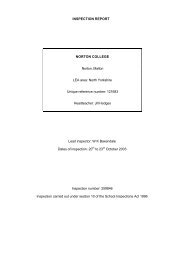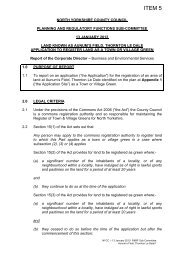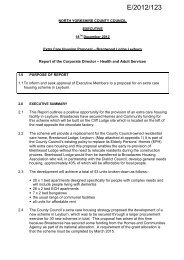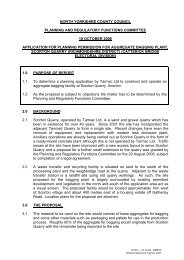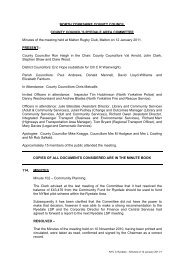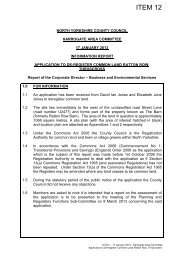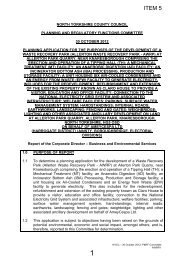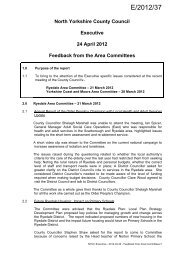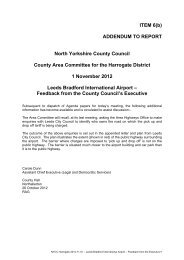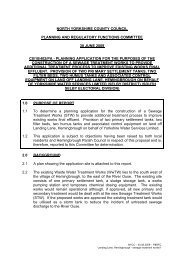Design Standards for Developer Funded Highway Works
Design Standards for Developer Funded Highway Works
Design Standards for Developer Funded Highway Works
Create successful ePaper yourself
Turn your PDF publications into a flip-book with our unique Google optimized e-Paper software.
ITEM 4NORTH YORKSHIRE COUNTY COUNCILTRANSPORT, ECONOMY AND ENVIRONMENTOVERVIEW AND SCRUTINY COMMITTEE17 JULY 2012DESIGN STANDARDS FOR DEVELOPER FUNDED HIGHWAY WORKSReport of the Corporate Director – Business and Environmental Services1.0 PURPOSE OF REPORT1.1 The purpose of this report is to seek Members views on a proposed Policy <strong>for</strong>the application of appropriate design standards <strong>for</strong> developer funded roadworks within North Yorkshire2.0 BACKGROUND2.1 There are two national standards that apply to road design; <strong>Design</strong> Manual <strong>for</strong>Roads and Bridges (DMRB) and Manual <strong>for</strong> Streets (MfS). DMRB is producedby <strong>Highway</strong>s Agency (HA) and is the design standard <strong>for</strong> the Strategic RoadNetwork (SRN) (Trunk Roads). MfS is advice on road design which was firstpublished in 2007 by the Department <strong>for</strong> Communities and Local Governmentand the Department <strong>for</strong> Transport and initially focussed on the design of lightlytrafficked residential estate roads. There is an area of overlap between the twostandards.2.2 The two documents apply different standards <strong>for</strong> visibility splays at accesses.The choice of which standard to apply can make the difference betweenapproval and refusal of development proposals. Whilst this is a matter <strong>for</strong>engineering judgement the County Council (NYCC) as Local <strong>Highway</strong> authority(LHA), needs to have robust guidance in place to support officer’s judgement inthe choice of standard used in assessing developer’s proposals through theplanning process.2.3 Visibility splays at any entrance or junction are measured along the edge of themain road (the “Y” distance) from a point a set distance back from the edge ofthe main road (the “X” distance). The “Y” distance is set by the speed of trafficand is not dependent on volumes of traffic using either the main road or theaccess. It is in the assessment of the “Y” distance that the two standards differ.2.4 A briefing note was approved by the Corporate Director, BES in November 2007(Appendix 1) which generally indicated that all highways in built up areas with adesign speed below 60 kph were to be classified as “streets” and highwaysNYCC – 17 July 2012 - TEE O&S Committee<strong>Design</strong> <strong>Standards</strong> <strong>for</strong> <strong>Developer</strong> <strong>Funded</strong> <strong>Highway</strong> <strong>Works</strong>/1
outside the built up area or with design speeds above 60kph were to be “roads”.Experience since then has shown that a more <strong>for</strong>mal policy is required. .2.5 The choice of the appropriate standard to apply is not a straight<strong>for</strong>ward matter.A matrix, attached at Appendix 2, is proposed to enable a defensible decision tobe made.3.0 THE TWO STANDARDS3.1 DMRB3.2 This is produced by HA as the mandatory design standard <strong>for</strong> the SRN. It isalso used by most LHAs, including NYCC, as the appropriate design standard<strong>for</strong> major roads. The main emphasis of the standard is providing a safe roadnetwork <strong>for</strong> vehicles. It has been used to design all major bypass schemeswithin North Yorkshire and is the standard being used <strong>for</strong> BALB. Carriagewaysdesigned to this standard are defined as “roads”3.3 MfS3.4 The reference to MfS is a generic term which is applied to two documents, MfS1and MfS2. MfS1 was produced as a more appropriate standard to apply to lighttraffic residential roads. MfS2 expanded on the MfS1 principles and theimportance of the public place and applied this to high streets and lightlytrafficked lanes in rural areas. It also indicates the strict application of DMRB israrely appropriate in urban areas. It also bases its stopping distances onresearch which gives different major road or “y” stopping distances from DMRB.Carriageways designed to this standard are known as “streets”.3.5 The “y” distances required by the two standards are as follows:-mph<strong>Design</strong> SpeedkphDMRB “y” distanceMfS “y” distance(based on 0%gradient)60 100 215 m Not applicable50 80 160 m Not applicable40 64 120 m Not applicable*37 60 90m 6230 48 90 m 45 m25 40 Not applicable 34 m20 32 Not applicable 24 m* Threshold <strong>for</strong> MfS Stopping Distances3.6 The ability <strong>for</strong> a developer to apply MfS standards will enable some sites to bedeveloped which could not be developed with DMRB. This places pressure onLHA officers to accept MfS standards.NYCC – 17 July 2012 - TEE O&S Committee<strong>Design</strong> <strong>Standards</strong> <strong>for</strong> <strong>Developer</strong> <strong>Funded</strong> <strong>Highway</strong> <strong>Works</strong>/2
4.0 THE ISSUES4.1 Officers considering developers’ proposals on the existing NYCC highwaynetwork need to be able to make a defensible decision on whether DMRB orMfS design standards are to apply based on current advice and soundengineering judgement. The decision is particularly important <strong>for</strong> applications<strong>for</strong> accesses to the existing highway network from development.4.2 MfS 2 advice indicates DMRB is rarely appropriate <strong>for</strong> roads which are not partof the SRN. Whilst this advice may be appropriate <strong>for</strong> many LHAs the particularcharacter of much of NYCC’s highway network means rigid application of theMfS2 advice would be inappropriate.4.3 NYCC’s highway network has many inter-urban A class roads with a string ofvillages along them <strong>for</strong> example the A170, A684 and A63. Whilst speed limitsare reduced through the villages, the place function is always dominated by themovement function of the A road traffic. In these locations it would often beinappropriate to allow design standards to be relaxed below those from DMRBto the street standards advocated by MfS. In the case of the A63 its previousstatus as part of the Trunk Road network meant that DMRB standards had to beapplied. Once it was “de-trunked” and became part of NYCC’s highway networkMfS advice indicated it would be considered as a “street” with MfS standardsapplying. This was without any changes on the ground to alter the character ofthe road <strong>for</strong> drivers. There are several heavily trafficked B Class roads that alsofall in this category.4.4 When considering new roads by developers guidance is much clearer. All newresidential estate roads are designed as “streets“ to MfS. All new inter urbanroutes are designed to DMRB. There are some major urban link roads where ahybrid is being developed. The carriageway and side road junctions are beingdesigned to DMRB <strong>for</strong> 30mph with the pedestrian areas and margins to thecarriageway being designed with an MfS philosophy.5.0 THE PROPOSED MATRIX5.1 The proposed matrix (Appendix 2) enables officers to make a professionaljudgement given the location of the site and establish which standard isappropriate.5.2 It is based upon the place and movement matrix contained in MfS2. Thesebalance the emphasis needed to be given to the “place” function against the“movement” characteristics <strong>for</strong> the particular location. The matrix has beenprepared to take account of the particular characteristics of NYCC’s highwaynetwork.5.3 Appendix 3 gives examples of how existing roads within North Yorkshire wouldfit in the matrix.NYCC – 17 July 2012 - TEE O&S Committee<strong>Design</strong> <strong>Standards</strong> <strong>for</strong> <strong>Developer</strong> <strong>Funded</strong> <strong>Highway</strong> <strong>Works</strong>/3
6.0 CONSULTATION6.1 The proposed matrix has been considered at a meeting of the “North YorkshireDevelopment Management Officer’s Group”; this is part of the North YorkshirePlanning Officer’s Group (NYPOG) network and is attended by all ten PlanningAuthorities within North Yorkshire.6.2 The group welcomed the matrix as it would enable robust advice to be providedby the LPAs. The prudence of revisiting the advice and updating it with robustadvice that has been the subject of consultation was also noted.6.3 The proposed policy will be the subject of a report to the Executive which willinclude the views of this committee.7.0 PROGRAMME FOR DELIVERY7.1 To secure <strong>for</strong>mal adoption by NYCC and to give the policy maximum weight it isproposed that a report is produced <strong>for</strong> the Executive and the <strong>for</strong>mal adoption issought through the full County Council meeting.7.2 It is hoped that, following adoption by NYCC, the ten individual PlanningAuthorities within North Yorkshire will also adopt the guidance and matrix withintheir own planning processes.8.0 EQUALITIES IMPLICATIONS8.1 Consideration has been given to the potential <strong>for</strong> any equality impacts arisingfrom the recommendation. It is the view of officers that the recommendationdoes not have an adverse impact on any of the protected characteristicsidentified in the Equalities Act 2010.9.0 FINANCE9.1 There are no financial implications associated with the introduction of theseproposals.10.0 CONCLUSIONS10.1 Advice is needed on when to apply DMRB and MfS. The prudence of revisitingthe advice and updating it with robust advice has been identified.10.2 New advice based upon a matrix comparing “movement” and “place” functionsis proposed. This will provide a robust position from which to assessdevelopers’ proposals.NYCC – 17 July 2012 - TEE O&S Committee<strong>Design</strong> <strong>Standards</strong> <strong>for</strong> <strong>Developer</strong> <strong>Funded</strong> <strong>Highway</strong> <strong>Works</strong>/4
10.3 The new advice needs to be <strong>for</strong>mally adopted as NYCC Policy. It is also hopedthat, the ten individual Planning Authorities within North Yorkshire will alsoadopt the guidance and matrix within their own planning processes.11.0 RECOMMENDATION11.1 Members views are sought on the proposal to adopt a policy that uses the matrixin Appendix 2 is accepted as the appropriate mechanism <strong>for</strong> guiding engineeringjudgement in determining when <strong>Design</strong> Manual <strong>for</strong> Roads and Bridges (DMRB)or Manual <strong>for</strong> Streets (MfS) standards should apply.DAVID BOWECorporate Director – Business and Environmental ServicesAuthor of Report: Pam JohnsonBackground Documents: NoneNYCC – 17 July 2012 - TEE O&S Committee<strong>Design</strong> <strong>Standards</strong> <strong>for</strong> <strong>Developer</strong> <strong>Funded</strong> <strong>Highway</strong> <strong>Works</strong>/5
APPENDIX 1NYCC – 17 July 2012 - TEE O&S Committee<strong>Design</strong> <strong>Standards</strong> <strong>for</strong> <strong>Developer</strong> <strong>Funded</strong> <strong>Highway</strong> <strong>Works</strong>/6
NYCC – 17 July 2012 - TEE O&S Committee<strong>Design</strong> <strong>Standards</strong> <strong>for</strong> <strong>Developer</strong> <strong>Funded</strong> <strong>Highway</strong> <strong>Works</strong>/7
NYCC – 17 July 2012 - TEE O&S Committee<strong>Design</strong> <strong>Standards</strong> <strong>for</strong> <strong>Developer</strong> <strong>Funded</strong> <strong>Highway</strong> <strong>Works</strong>/8
Road= DMRB <strong>Standards</strong>Street = MfS <strong>Standards</strong> Assessment MatrixAPPENDIX 2A RoadsNYCC categories 2;3a and 3bB and C RoadsAll NYCC categoriesUnclassified RoadsAll NYCC categoriesEstate RoadsNYCC categories 4a and 4bNo Place status Some Place Status Significant Place Status60 mph speed limitVehicles take priorityThrough traffic dominatesAny pedestrians intimidated by trafficGenerally in open countrysideNo sense of space60 mph speed limitVehicles take priorityThrough traffic dominatesAny pedestrians intimidated by trafficGenerally in open countrysideNo sense of space60 mph speed limitVehicles take priorityThrough traffic dominatesAny pedestrians intimidated by trafficGenerally in open countrysideNo sense of spaceIndustrial Estate roadsHGVs dominateVehicles take priorityNo sense of spaceGenerally 60 or 40 mph speed limitVehicles take priorityThrough traffic dominatesPedestrians feel intimidated by trafficSome limited sense of spaceGenerally 60 or 40 mph speed limitVehicles take priorityThrough traffic dominatesPedestrians feel intimidated by trafficSome limited sense of spaceGenerally 60 or 40 mph speed limitVehicles take priorityThrough traffic dominatesPedestrians feel intimidated by trafficSome limited sense of space30 mph speed limitspeeds at or below limitvehicles subservient to pedestrianspedestrian usagepedestrians feel safe30 mph speed limitspeeds at or below limitvehicles subservient to pedestrianspedestrian usagepedestrians feel safeUsually 30 or 40 mph speed limitVehicles take priorityThrough traffic dominatesPedestrians feel intimidated by trafficspace functions subservient to traffic20 or 30 mph speed limitspeeds at or below limitvehicles respect pedestrians at peak pedestriantimesheavy pedestrian footfall particularly at peakpedestrian timespedestrians feel saferoad and footway lightingUsually 30 or 40 mph speed limitVehicles take priorityThrough traffic dominatesPedestrians feel intimidated by trafficspace functions subservient to traffic20 or 30 mph speed limitspeeds at or below limitvehicles respect pedestrians at peak pedestriantimesheavy pedestrian footfall particularly at peakpedestrian timespedestrians feel saferoad and footway lightingUsually 30 or 40 mph speed limitVehicles take priorityThrough traffic dominatesPedestrians feel intimidated by trafficspace functions subservient to traffic20 or 30 mph speed limitspeeds at or below limitvehicles respect pedestrians at peak pedestriantimesheavy pedestrian footfall particularly at peakpedestrian timespedestrians feel saferoad and footway lighting20 or 30 mph speed limitspeeds at or below limitvehicles respect pedestrianspedestrian usagepedestrians feel safemay be litNYCC – 4 May 2012 - Executive Members<strong>Design</strong> <strong>Standards</strong> <strong>for</strong> <strong>Developer</strong> <strong>Funded</strong> <strong>Highway</strong> <strong>Works</strong> (DMRB or MFS)/9
APPENDIX 3EXAMPLES OF EXISTING ROADS WITHIN NORTH YORKSHIRE AND HOW THEY WOULD FIT IN THE MATRIXNo Place status Some Place Status Significant Place StatusA RoadsNYCC categories 2;3a and 3b• A684 between villages• A170 from Sutton bank to Helmsley• A19 South of York• A63 east of the A1• BALB• A61 at Carlton Miniott• A167 Darlington Road , outside Sam Turners• A684 Aiskew• A63 Hambleton• A684 at West Witton• A170 Aislaby• A61 Thirsk Market Place• A170 HelmsleyB and C RoadsAll NYCC categories• B6265 from A1 to Masham• B6271 <strong>for</strong>m Northallerton to Scorton• C1 from Hutton Rudby to Stokesley• B6265 At Nosterfield• C422 Ripon Bypass to Clock Tower• B1448 Thirsk to South Kilvington• B1448 South Kilvington• B1448 South Kilvington• B1263 Scorton GreenUnclassified RoadsAll NYCC categories• White Horse Bank• Horne Road from Catterick to Tunstall• Brompton Road Northallerton• Dolly lane •• Northallerton Road Brompton• Northallerton High StreetEstate RoadsNYCC categories 4a and 4b • Standard Way industrial Estate• Broomfield Avenue• Gravel Hole Lane • L’Espec StreetNYCC – 4 May 2012 - Executive Members<strong>Design</strong> <strong>Standards</strong> <strong>for</strong> <strong>Developer</strong> <strong>Funded</strong> <strong>Highway</strong> <strong>Works</strong> (DMRB or MFS)/11


